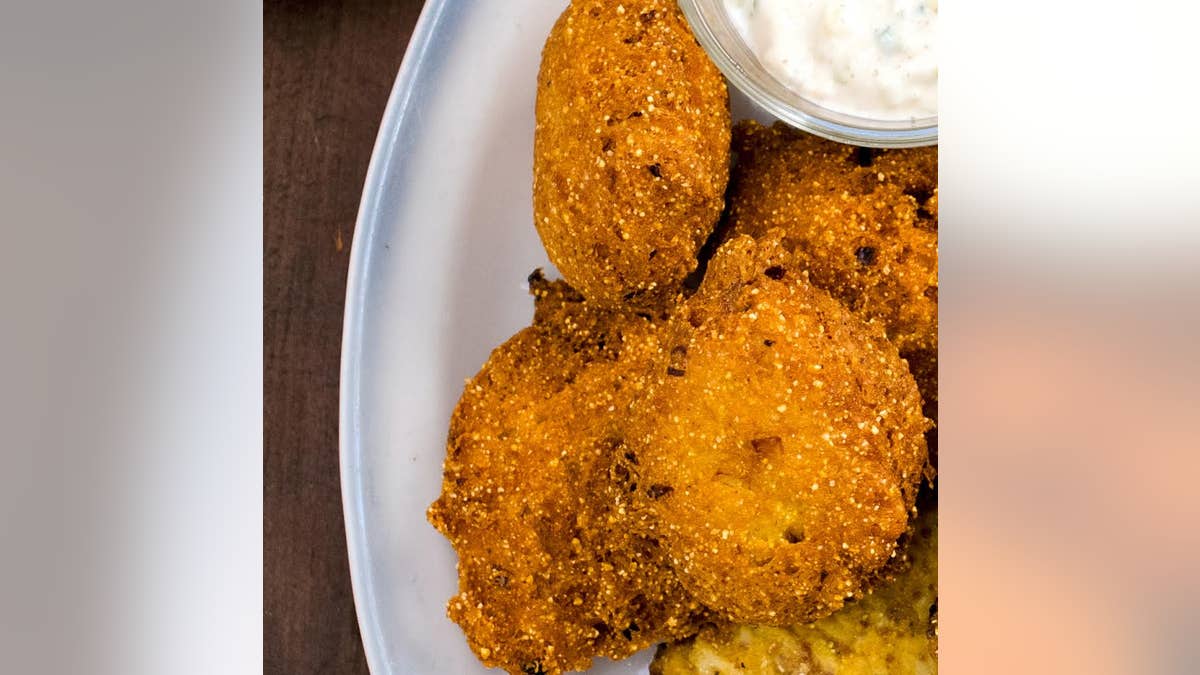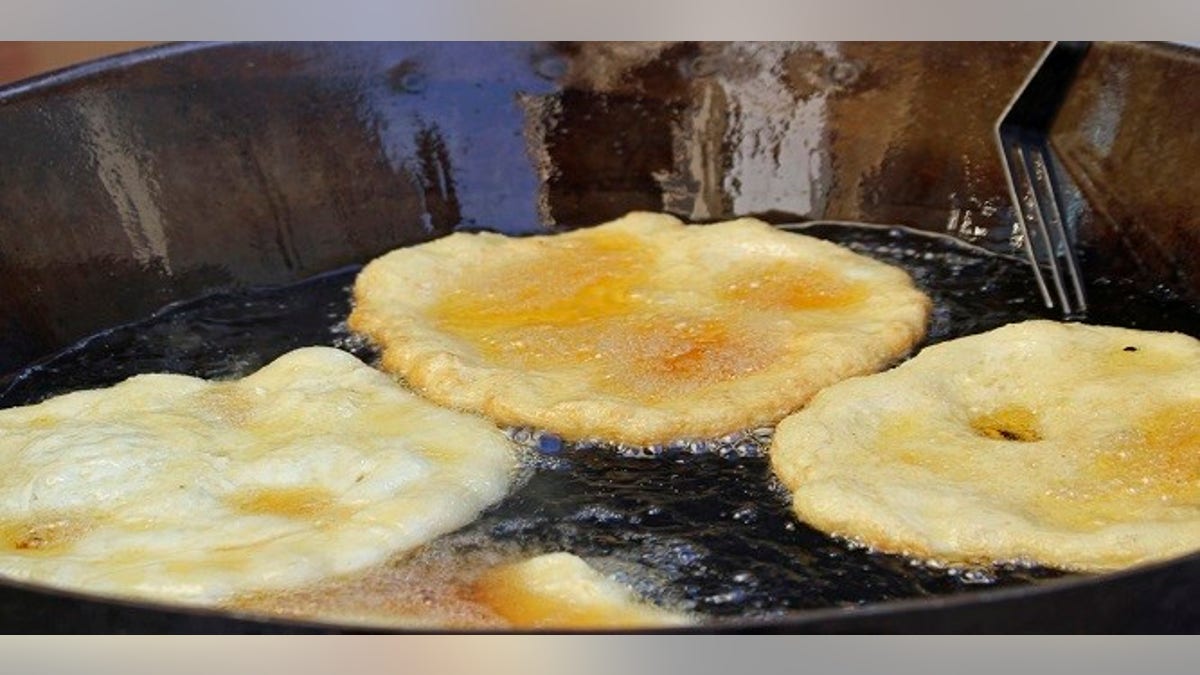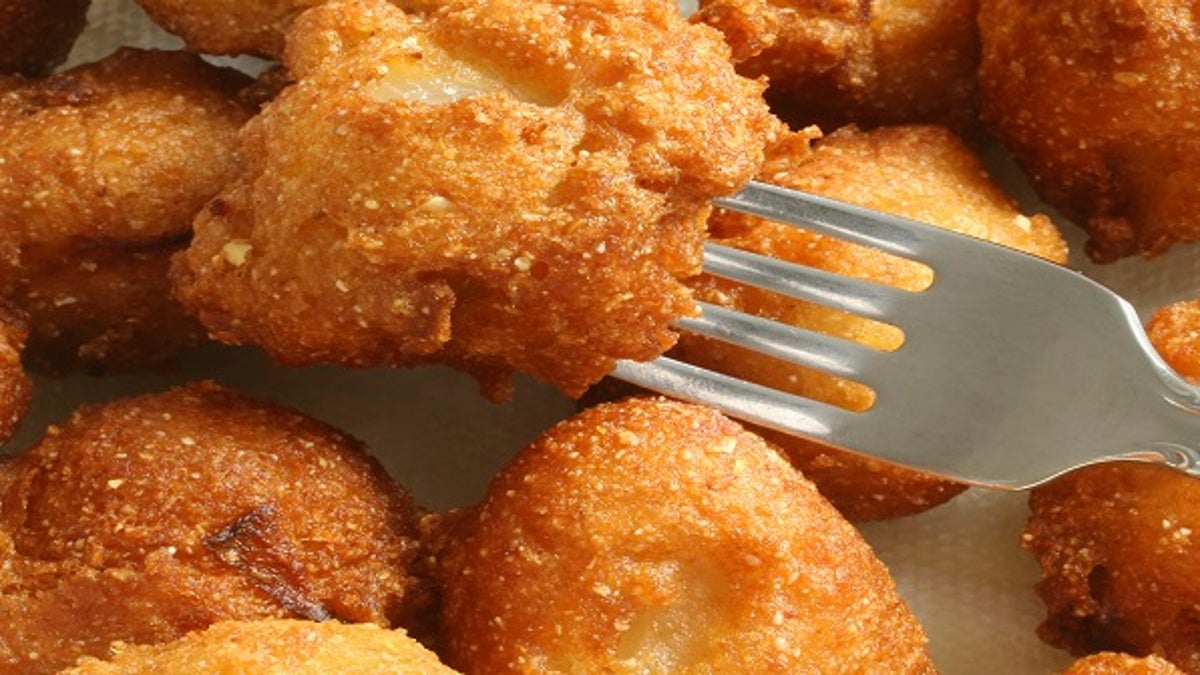
Hushpuppies are deep-fried cornbread, made from leftover cornbread batter. (Ellen Silverman)
If someone asked you to define a fritter, you wouldn’t have to fritter away too much time coming up with an answer. They’re small bites made with a batter of flour or cornmeal, eggs, milk and maybe something stuffed inside.
But you might be surprised to learn that within the culinary world, a great debate rages over what falls into the fritter category.
First, a bit of history.
Today, fritters are regarded as casual finger-food. But they once were the stuff of cloth napkins and white tablecloths.
President Grover Cleveland served them at Thanksgiving in 1887, according to Gourmet.com. The recipe called for mashing boiled parsnips with flour, egg and salt, adding lard to a pan “over the fire,” spooning in the parsnip mixture and frying till “delicate brown.”
But those first fritters lacked the batter-dipped/batter-enrobed crunch that people expect today.
Classically trained Southern chef Virginia Willis says fritters are anything coated in batter and deep-fried. But she says she thinks of “beignets” as fritters, and there’s “nothing inside them.” Ditto for hushpuppies, she says.
There are exclusions, too. Corn dogs and tempura are battered and fried, but they’re not fritters.
Seriouseats.com culinary director and food scientist Kenji López-Alt says fritters are “any fried thing that’s relatively small … a bite-sized portion of batter or dough” that may or may not have fillings. Yes, he says, a Dunkin’ Munchkin is a fritter.
This is all besides the point, says Tim Murphy, author of Flannel John’s Woods & Water Cookbook: Critters, Fritters, Chili & Beer. It doesn’t matter what they are, he says, because they combine his two favorite food groups: doughnuts and fried food.
Guys may not know what a fritter is, “but they relate to those food groups,” Murphy says. “We are simple, lazy creatures who just want to get fed.” Fritters are fast, easy and hard to mess up. They’re the quintessential, “man food,” says Murphy, who donates 25 percent of all sales to the Wounded Warrior Project.
While people have differing views on what begets a fritter, here’s one thing everyone agrees on:All things that are fried are not fritters, but all fritters are fried.

tasty Fried Apple fritters in the cauldron of boiling oil on sale at the market (iStock)
The following are indisputably fritters:
Apple Fritters: Doughnut batter mixed with chopped apples and cinnamon.
Corn Fritters: Savory, cornmeal-based batter with a pinch of sugar, milk and eggs mixed with canned or fresh corn.
Hushpuppies: Deep-fried cornbread, made from leftover cornbread batter. Often flavored with chopped or green onion. Red pepper and jalapeño are commonly added. Though they’re traditionally served with barbecue, Willis suggests “chef-ing it up” with seafood.

(iStock)
Festivals: Jamaican “hushpuppies,” also known as “Jamaican corn fritters.”Cornmeal and flour-based dough with added sugar and occasionally vanilla. Festivals are mixed into a dough, shaped like torpedoes and coated in flour and cornmeal before deep-frying. Also called Maize festival dumplings.
Sorullos (or Sorullitos) de Maiz: Puerto Rican “hushpuppies.” Also called Puerto Rican corn fritters or corn sticks. Made from a cooked dough, as is pâte àchoux (the base for cream puffs and eclairs). Blend water, salt, sugar and cornmeal over low heat until it forms a ball. Roll into cigar-shaped pieces and deep-fry.
Arancini: Egg- and breadcrumb-coated deep-fried rice ball, with molten cheese center or melted cheese bits throughout. Means “oranges” in Italian. Made with leftover risotto (arborio rice cooked with stock, parmesan, vegetables or seafood) to which egg, cream or additional parmesan can be added. Roll into a ball, insert mozzarella or fontina, seal, fry.
Calas: Creole breakfast fritters. Sweet batter blended with cooked rice, fried and dusted with confectioner’s sugar. Like a doughnut with added rice. Calas originated with slaves who came from rice-growing regions of Africa. Native New Orleans cookbook author and food preservationist Poppy Tooker has revived this New Orleans tradition almost singlehandedly.
Onion Pakora/Onion Bahji: Deep-fried onion fritter. Called “pakora” in northern India, “bahji” in southern India, “pakoda” in Southeast Asia. Dredge sliced, raw onions in a mixture of rice flour and chickpea flour (also called “besan” or “gram”) and seasonings. Those flours fry up crispier than wheat flour. Some recipes let the onion’s water content moisten the batter; others add minimal water. Resembles a small bird’s nest. Note: Spinach, eggplant and potato are often dipped in a thinner version of this batter, resulting in dishes similar to tempura.
Latkes: Potato fritter served at Hanukkah. Made with shredded potatoes and onions squeezed dry in cheesecloth, then mixed with eggs, salt, matzoh meal or flour. Shallow-fried in cast iron frying pan. Traditionally served with applesauce and sour cream.
Zeppole: Southern Italian pastry made with a cooked flour, butter and egg-based dough, like a pâte à choux — the base for eclairs and cream puffs. Plain zeppole are generously dusted with confectioner’s sugar or rolled in cinnamon and sugar after frying.
Carimañolas: Colombian and Panamanian fritters made with a boiled and mashed yucca dough, filled with meat or cheese, formed into an oblong shape and deep-fried.
Buñuelos: Argentinian vegetable fritter made with various fillings such asspinach (Buñuelos de Espinaca), chard (Buñuelos de Acelga) or apples (Buñuelos de Manzana.) Similar to latkes, except made with frozen spinach instead of potatoes. “Buñuelos” also refer generically to variations of fried dough ranging from balls to thin disks, from sweet to savory, topped with sugar, drenched in sweetened syrups, filled and unfilled. Popular in South American and Central American countries as well as Puerto Rico.




















